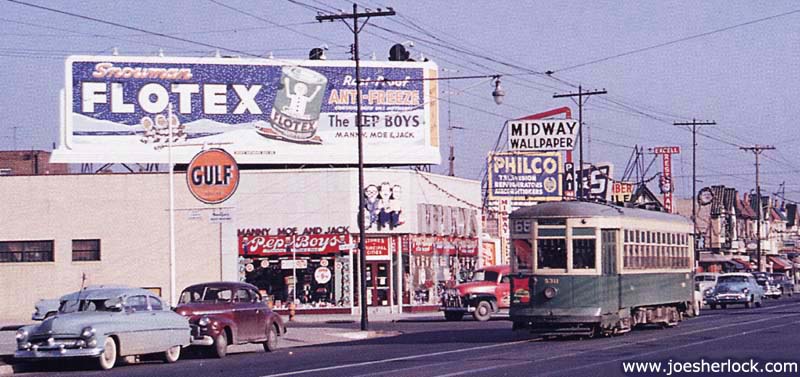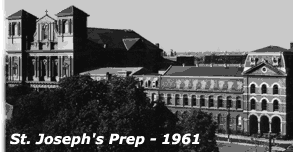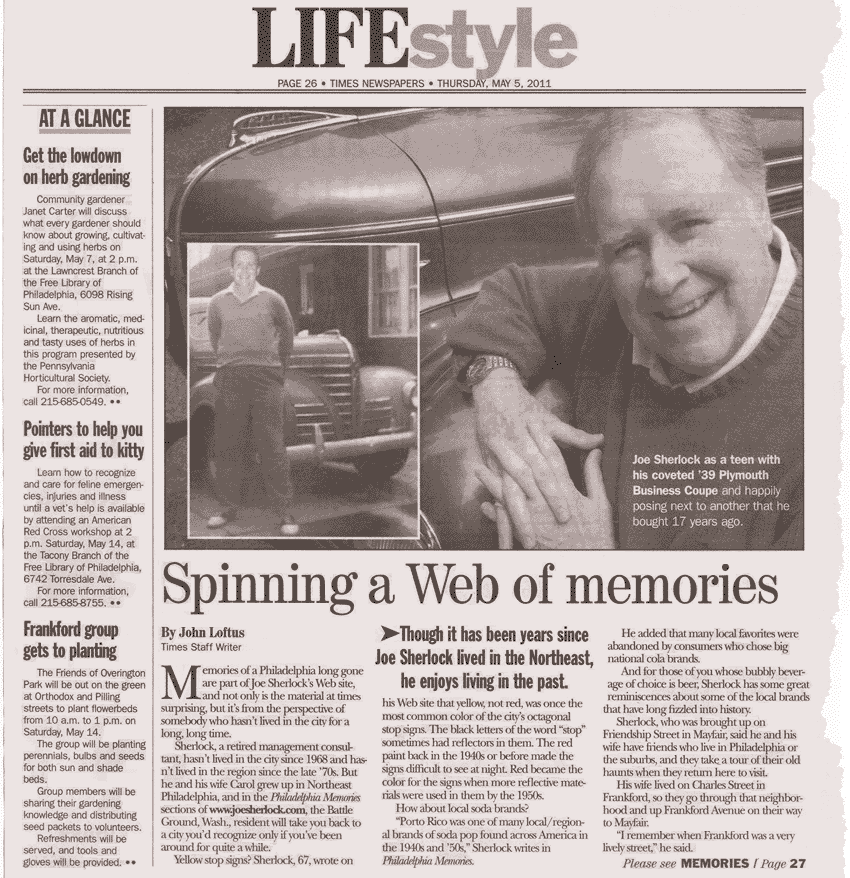'Spinning a Web of Memories'
by John Loftus, Northeast Times Staff Writer (posted 5/10/11)
|
|
|
Joe Sherlock in Washington State with his latest 1939 Plymouth
|
Memories of a Philadelphia long gone are part of Joe Sherlock's Web site, and not only is the material at times surprising, but it's from the perspective of somebody who hasn't lived in the city for a long, long time.
Sherlock, a retired management consultant, hasn't lived in the city since 1968 and hasn't lived in the region since the late '70s. But he and his wife Carol grew up in Northeast Philadelphia, and in the Philadelphia Memories sections of www.joesherlock.com, the Battle Ground, WA resident will take you back to a city you'd recognize only if you've been around for quite a while.
 Yellow stop signs? Sherlock, 67, wrote on his Web site that yellow, not red, was once the most common color of the city's octagonal stop signs. The black letters of the word 'stop' sometimes had reflectors in them. The red paint back in the 1940s or before made the signs difficult to see at night. Red became the color for the signs when more reflective materials were used in them by the 1950s. Yellow stop signs? Sherlock, 67, wrote on his Web site that yellow, not red, was once the most common color of the city's octagonal stop signs. The black letters of the word 'stop' sometimes had reflectors in them. The red paint back in the 1940s or before made the signs difficult to see at night. Red became the color for the signs when more reflective materials were used in them by the 1950s.
How about local soda brands? "Porto Rico was one of many local/regional brands of soda pop found across America in the 1940s and '50s," Sherlock writes in Philadelphia Memories. He added that many local favorites were abandoned by consumers who chose big national cola brands.
And for those of you whose bubbly beverage of choice is beer, Sherlock has some great reminiscences about some of the local brands that have long fizzled into history.
Sherlock, who was brought up on Friendship Street in Mayfair, said he and his wife have friends who live in Philadelphia or the suburbs, and they take a tour of their old haunts when they return here to visit.

Frankford Ave. & Friendship St. - early 1950s
His wife lived on Charles Street in Frankford, so they go through that neighborhood and up Frankford Avenue on their way to Mayfair. "I remember when Frankford Ave. was a very lively street," he said.
The city also was a very lively newspaper town. "Philadelphia was once divided into two camps: Bulletin people and Inquirer people. Different tastes, different views, different comics," he wrote in his blog. He describes his family as 'Bulletin people'. "I married a girl whose family were Philadelphia Inquirer people. (Who says mixed marriages don't work?)," he wrote.
His Web site in its present form evolved from a blog he started writing as he was winding down his career - a career that took many forms over the years and eventually took him from the Philadelphia area to the nation's Northwest.
 Besides Mayfair, Sherlock lived in Frankford and Winchester Park. He attended St. Matthew and St. Martin of Tours parish schools, then went to St. Joseph's Prep before going on to Villanova and taking grad courses at Drexel. Besides Mayfair, Sherlock lived in Frankford and Winchester Park. He attended St. Matthew and St. Martin of Tours parish schools, then went to St. Joseph's Prep before going on to Villanova and taking grad courses at Drexel.
During a phone chat two weeks ago, he said one of the differences that mark Philadelphians is that, when they ask you what school you attended, they are referring to grade school or high school. "Everywhere else, that means college," he said, adding that, when you answer, Philadelphians have you pegged.
Sherlock's professional life began at Uniroyal on Cottman Avenue near State Road. He then worked a dozen years for Rohm and Haas - in Bristol, first, and then in Center City.
In 1968, Sherlock moved to Willingboro, N.J., and commuted to his job. In 1978, the move west came when Sherlock and a partner bought a plastics manufacturing business in Oregon. That was almost half a lifetime ago, and any vestiges of the famous Philadelphia accent now are faint when Sherlock speaks.
And he hears about that. In Washington, he said, people notice something different about the way he speaks, but when he talks to Philadelphians, they tell him he sounds like he has a radio announcer's voice.
Through the 1980s, the plastic business grew and it was sold before 1990. Sherlock then started work as a management consultant. Before long, he began using the Internet to attract clients. His Web site brought plenty of business his way, but by 2004, Sherlock was thinking of retiring. Instead of using the site to drum up work, he used it to blog. In a few years, there was so much material on the 'Temple of Joe' that Sherlock started categorizing everything.
That's how the several pages of Philadelphia Memories began.
Sherlock said he gets material from all over, especially from books on Philadelphia that his family members buy for him. "Occasionally," he added, "I found photos in family albums."
On the fourth page of memories, Sherlock talks about the now-closed Bookbinder's seafood restaurant at Second and Walnut streets under the heading 'Another Icon Gone'. "Beginning as a lowly oyster bar, Bookbinder's moved to Second and Walnut streets in 1898 to be closer to the Delaware River docks. And began its ascent to eventually emerge as one of Philly's best-known dining establishments," he wrote.
If you're nostalgic for something more than items about mid-century Philadelphia, Sherlock's site includes a lot about cars and model trains. The car talk explains why there's no mention of our city's sports teams in the 'Temple of Joe', he said.
Sherlock calls himself a 'car guy', which obviates any real interest in pro sports. "Car guys are never sports guys," he said.***
|
|
In May, 1959, 15 year-old Joe Sherlock posed in front of his first car, a 1939 Plymouth business coupe. He learned to drive in this automobile. The photo was taken in the driveway of his grandmother's Foulkrod Street home in the Northwood Park section of Frankford.
|
His favorite classic car is the 1939 Plymouth business coupe - as a teen, he learned how to drive in one. The auto was popular with traveling salesmen because they could carry a lot of their samples in the Plymouth's big trunk.
"My father bought it for $25," he said. His dad was the car's 14th owner, he added, noting that the vehicle "was a real piece of crap, but I loved it." That love was long-lasting, but that first car was not. Soon after Sherlock got his license, the coupe got mangled in an accident and had to be junked.
He bought another 1939 Plymouth Business Coupe in 1994, "and it cost a helluva lot more than twenty-five dollars," Sherlock said.
Model trains are one of his loves, too, and his most prized set is a Lionel Hiawatha. It also represents a blast from his own past, Sherlock said. When he was growing up, his father, a longtime Pennsylvania Railroad man, built a three-level train layout.
|
|
|
Lionel train layout in Friendship St. living room - 1947
|
On the bottom level was a Hiawatha, he said. He doesn't know what happened to the set of his childhood, but the Hiawatha was reissued in 1988. Eleven years later, he found one online and bought it.
|
|
|
Orange & gray Lionel Hiawatha locomotive on Joe's current layout
|
After all, as Joe Sherlock knows, you can't put a price on memories.

***A Touch Of Fame: In early May 2011, the Northeast Times, a weekly Philadelphia newspaper with a circulation of 110,000 or so, did a profile of me. Writer John Loftus was fun to chat with and wrote a very nice article.
 I wanted to clarify one thing I apparently said in the interview: "Sherlock calls himself a 'car guy,' which obviates any real interest in pro sports. "Car guys are never sports guys," he said." I wanted to clarify one thing I apparently said in the interview: "Sherlock calls himself a 'car guy,' which obviates any real interest in pro sports. "Car guys are never sports guys," he said."
This was during a two-hour phone discussion. If I said that, what I really meant to say was, "Hard-core car guys are never hard-core sports guys."
From my experience in car clubs and real life, people who have extensive historical knowledge of cars and can spout various automotive data at the drop of a hat will have no room left in their brains for sports history or statistics. In my lifetime, I've never met a serious car guy who was a major-league sports enthusiast.
Anyone who can tell you the horsepower rating of a 1963 VW (40), the number of wires on the typical classic Boranni wire wheel (88) or the wheelbase of a Continental Mark II (125 inches), are almost never knowledgeable about the win/loss record of the Phillies in 1959, nor will they know Richie Ashburn's career home run record. (By the way, I didn't look up any of the car stats quoted; they're in my head.)
Once your brain is full, if you try to cram more stuff in, you'll lose other, valuable information.
Most everyone knows who Joe Namath is and most will also recognize Dale Earnhardt as well. But as you dig into more obscure names, the differences become apparent. Few staunch basketball fans know of Zora Arkus-Duntov and most dyed-in-the-wool car guys won't remember Elgin Baylor. That said - there are lots of people who are casual car guys and also semi-sports fans. And vice versa.
Last month, I posted a new photo of myself at the top of my bio page. My wife took it. It's the same photo the newspaper used in the print version of the NE Times article. (permalink)
PS: The article in Philadelphia's Northeast Times drove about 350 additional visitors to the initial Philly page on my web site, according to my server logs.
copyright 2011-21 - Joseph M. Sherlock - All applicable rights reserved
Disclaimer
The facts presented on this website are based on my best guesses and my substantially faulty geezer memory. The opinions expressed herein are strictly those of the author and are protected by the U.S. Constitution. Probably.
Spelling, punctuation and syntax errors are cheerfully repaired when I find them; grudgingly fixed when you do.
If I have slandered any brands of automobiles, either expressly or inadvertently, they're most likely crap cars and deserve it. Automobile manufacturers should be aware that they always have the option of trying to change my mind by providing me with vehicles to test drive.
If I have slandered any people or corporations, either expressly or inadvertently, they should buy me strong drinks (and an expensive meal) and try to prove to me that they're not the jerks I've portrayed them to be. If you're buying, I'm willing to listen.
Don't be shy - try a bribe. It might help.
|

